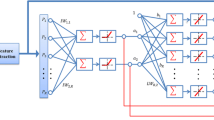Abstract
One of the distinctive features of musculoskeletal systems is the redundancy provided by agonist-antagonist muscle pairs. To identify agonist-antagonist muscle pairs in a musculoskeletal robot, however, is difficult as it requires complex structures to mimic human physiology. Thus, we propose a method to identify agonist-antagonist muscle pairs in a complex musculoskeletal robot using motor commands. Moreover, the common dimensional autoencoder, where the encoded feature has identical dimensions to the original input vector, is used to separate the image and the kernel spaces for each time period. Finally, we successfully confirmed the efficacy of our method by applying a 2-link planar manipulator to a 3-pairs-6-muscles configuration.
Access this chapter
Tax calculation will be finalised at checkout
Purchases are for personal use only
Similar content being viewed by others
References
Hosoda, K., Sekimoto, S., Nishigori, Y., Takamuku, S., Ikemoto, S.: Anthropomorphic muscular-skeletal robotic upper limb for understanding embodied intelligence. Adv. Robot. 26(7), 729–744 (2012)
Marques, H., Jantsch, M., Wittmeier, S., Holland, S., Alessandro, C., Diamond, A., Lungarella, M., Knight, R.: ECCE1: the first of a series of anthropomimetic musculoskeletal upper torsos. In: Proceedings of 10th IEEE-RAS International Conference on Humanoid Robots, pp. 391–396 (2010)
Shirafuji, S., Ikemoto, S., Hosoda, K.: Development of a tendon-driven robotic finger for an anthropomorphic robotic hand. Int. J. Robot. Res. 33, 677–693 (2014)
Ozawa, R., Hashirii, K., Kobayashi, H.: Design and control of underactuated tendon-driven mechanisms. In: Proceedings of IEEE International Conference on Robotics and Automation, pp. 1522–1527 (2009)
Sawada, D., Ozawa, R.: Joint control of tendon-driven mechanisms with branching tendons. In: Proceedings of IEEE International Conference on Robotics and Automation, pp. 1501–1507 (2012)
Hartmann, C., Boedecker, J., Obst, O., Ikemoto, S., Asada, M.: Real-time inverse dynamics learning for musculoskeletal robots based on echo state Gaussian process regression. In: Proceedings of Robotics: Science and Systems (2012)
Diamond, A., Holland, O.E.: Reaching control of a full-torso, modelled musculoskeletal robot using muscle synergies emergent under reinforcement learning. Bioinspiration Biomimetics 9, 016015 (2014)
Ikemoto, S., Duan, Y., Takahara, K., Kumi, T., Hosoda, K.: Robot control based on analytical models extracted from a neural network. In: The 1st International Symposium on Systems Intelligence Division (2018)
Author information
Authors and Affiliations
Corresponding author
Editor information
Editors and Affiliations
Rights and permissions
Copyright information
© 2019 Springer Nature Switzerland AG
About this paper
Cite this paper
Masuda, H., Ikemoto, S., Hosoda, K. (2019). Common Dimensional Autoencoder for Identifying Agonist-Antagonist Muscle Pairs in Musculoskeletal Robots. In: Strand, M., Dillmann, R., Menegatti, E., Ghidoni, S. (eds) Intelligent Autonomous Systems 15. IAS 2018. Advances in Intelligent Systems and Computing, vol 867. Springer, Cham. https://doi.org/10.1007/978-3-030-01370-7_26
Download citation
DOI: https://doi.org/10.1007/978-3-030-01370-7_26
Published:
Publisher Name: Springer, Cham
Print ISBN: 978-3-030-01369-1
Online ISBN: 978-3-030-01370-7
eBook Packages: Intelligent Technologies and RoboticsIntelligent Technologies and Robotics (R0)




